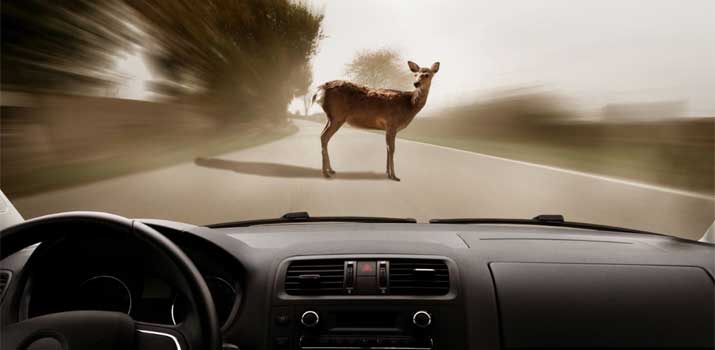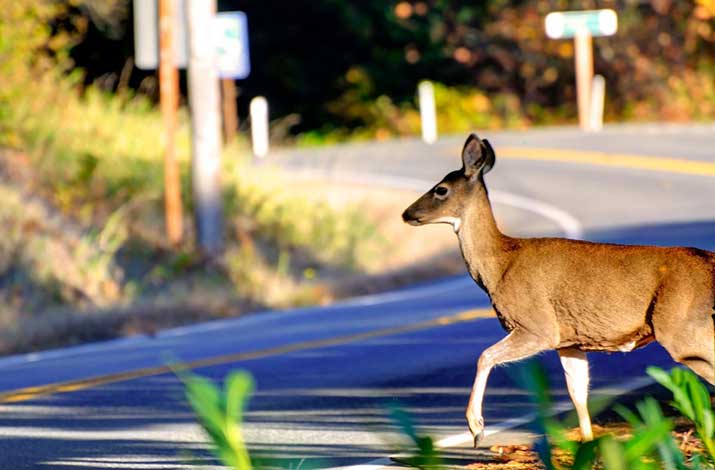We all cross paths with the odd suicidal deer at some point in our lives… you know the ones.

You’ll be driving along belting out “Dancing in the Dark” along with The Boss on the radio, then BOOM!
Out of nowhere, a deer bounds out into the road and beckons you into a dance with death!
If you’re lucky, you slam on or swerve out of the way in the nick of time and the deer with a death wish scarpers for the nearest cover.
But if you’re not so lucky, any number of terrible things can happen.
Whether you hit an obstacle whilst trying to avoid the deer or hit the poor creature itself, your vehicle’s almost certainly a write-off, and the deer, well… let’s just hope there’s a deer heaven, ay?
Deer-vehicle Collisions Can be Fatal
In some scenarios, these encounters can even wind up fatal for humans, so really, no one comes out on top, which begs the question of why deer do this in the first place.
Well, the “caught like a deer in headlights” saying didn’t come from nowhere, so let’s put this bizarre behavior under the microscope and see if we can’t find ways to minimize associated dangers.
Reasons A Deer Might Run Into The Roadway?
Believe it or not, there are actually a number of reasons why a deer might run into the road.
1. New Roads
In order to enhance the infrastructure of the nation and enhance connectivity between disparate locations, a wealth of new roads are being laid year after year, the majority of which snake through relative wilderness, where most deer live.
To deer in these locations, roads may well be a completely foreign concept, meaning they have no inkling of the danger they pose, so there’s a good chance they’ll roam across them without a care in the world.
2. Fear
Deer are famously timid creatures that will scarper at the crack of a twig, so, needless to say, the sound of your Toyota Corolla tearing up the asphalt can send them into a state of blind fear.
Have you ever experienced a similar fright? Logical thinking goes out the window as your fight-or-flight response takes the wheel, so to speak.
In light of this, a deer will simply run, not paying much attention to direction, so it’s not uncommon for them to end up on the road, especially if it’s a new build and the animal doesn’t understand what all the ruckus is about.
3. Path Of The Road
Sometimes deer do know what direction to run, but due to the sinuous nature of the roads, end up caught in the headlights of our vehicles anyway.
When a vehicle is at one point in the road, the sound may travel in one direction over the landscape, encouraging deer to run in the opposite direction.
However, little does the deer know that the road is made up of a sequence of sprawling turns and deep U-shaped bends, so they may still end up further down the very same road, with the vehicle fast approaching.
4. Essential Crossing
Why did the deer cross the road?… It’s not a joke, but a genuine question to which there is a multitude of answers.
Sometimes, deer need to cross the road simply because there’s something on the other side they must reach.
If food in their current area is close to depletion, for instance, they’ll have to explore new spots, some of which may only be reached by crossing the road.
Another reason a deer might well hit the asphalt without looking both ways is if a doe is heading back to her fawns.
See, does spend the majority of their time away from their young to reduce the chances of predators finding their hiding spot, but she must return a couple of times every 24-hour cycle in order to feed them milk.
Should the route to her babies cross a road, poor timing and poor luck may well see her in the path of your vehicle, which is a pretty heartbreaking consideration.
Not only will such a collision end the deer’s life but her young as well — Ahhh, cruel fate!
5. Rutting Season
When rutting season comes around, bucks go a little wacky and strike out lone wolf deer style in search of a mate, which is why they’ll often be crossing a road alone.
These poor horny creatures are only looking for a little bit of love and here we come along with our trucks and our motorcycles and our sport coupes and we annihilate them before they ever find it… tragic!
Why Do Deer Run Directly Towards Vehicles?
Hopefully, the next time you encounter a deer on the road, they have their wits about them and understand how to get away, but these peculiar animals are quite famous for staying perfectly still or actually running towards oncoming traffic.
It seems insane, but there’s a very good reason for both of these actions.
Deer technically aren’t nocturnal animals, but they do have spectacular vision.
In fact, their peepers are roughly five times more proficient than our own, a feat that gives them an edge in normal circumstances, but when they’re blasted by our headlights, it can be a real shock to their system.
In this state of blinding overwhelm, they won’t be able to see much of anything at all, and considering deer are typically long-sighted animals, the chance they’ll be able to figure out what’s happening is even slimmer.
Related: How Well Can Deer See In The Dark?
Can A Collision With A Deer Total Your Car?
Deer may be incredibly nimble and elegant, but that’s not to say they don’t carry some serious weight.

A full grown buck will weigh anything between 120 and 200 lbs. To put that into perspective for you, that’s the equivalent of a large refrigerator!
How To Reduce The Chances Of A Deer Collision
Before we go our separate ways, let’s hammer out a comprehensive hazard avoidance plan when using rural roads.
Slow Down
The best general advice I can give you to reduce your chances of colliding with a deer is to slow your roll.
Rural roads are incredibly dangerous before we even bring wandering deer into the equation, so you should be playing it safe anyway, but if you’re driving through deer country, you need to be exceptionally careful.
Drop at least 10 miles below the speed limit and take any blind sections very slowly in order to give you, the deer, and your vehicle the best chance of survival.
Consider The Hour
Deer can run out into the road at any time of day, but as crepuscular animals, they’re far more likely to be active during the half-light hours of dawn and dusk.
So, if you’re out and about during these ungodly hours, it pays to be especially cautious.
Consider The Date
As mentioned earlier, bucks are far more active and unpredictable during the rutting season, which plays out between October and December, meaning you’re more likely to run into them during fall and winter.
And as a result of the rutting season, does will be more active during spring when they’re either scavenging to support the development of their young or traveling further in order to outfox predators.
Stay Alert & Look Out For Warning Signs
Even if you’re driving during dusk or dawn, it’s essential to be vigilant, and if you see a sign warning of possible deer appearances, double your efforts to stay alert.
Exercise Caution After A Sighting
If you see one deer on or near the road ahead, don’t let your guard down if it moves on. These animals travel in herds and it may well be followed by more.
Honk Your Horn
Deer have fantastic hearing, so a honk of your horn can help thaw a frozen deer and get them on the move.
Improve Your Field Of Vision
Using your fog lights in poor light conditions is absolutely essential to avoiding potential calamity.
You’ll be able to see further ahead and to the sides of the road, giving you more time to react to the presence of a deer.
Final Thoughts
As it turns out, those daredevil deer aren’t looking for trouble; they’re just scared, confused, or trying to get someplace.
Remember, it’s not they that meddle in our territory, but we that meddle in theirs, so it’s entirely our responsibility to ensure our own and their safety — Drive slow, drive smart, and drive safe!
